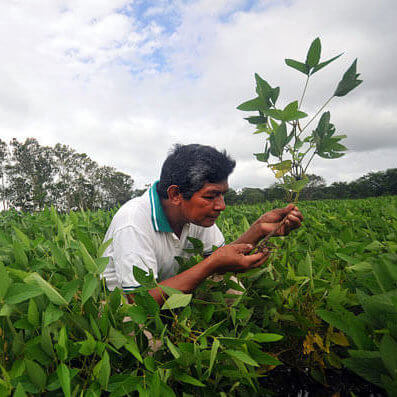During 2017, several advances were made in terms of experimental research, new commercial approvals, reviews of technology benefits and efforts to streamline regulatory frameworks. The 15 most relevant advances in the region during last year were:
15. Chilean university develops GM wheat with higher yield and grain weight
Scientists at the Austral University of Chile, in collaboration with colleagues from the University of New York, cloned a gene of the enzyme expanzin — a protein that allow the elongation of the cell walls of plants — from wheat to achieve the first transgenic wheat that increases both yield and grain weight. It is also expected to improve industrial quality.

14. Argentine scientists develop non-browning potatoes and hypoallergenic milk with gene editing
Researchers from the Institute of Agricultural Technology of Argentina (INTA), a state institution, used gene editing techniques to develop potatoes that don’t turn brown and milk that doesn’t affect allergic patients. In the case of potatoes, the genes of the sugars responsible for the browning process and production of acrylamide — a potential carcinogen — were silenced, or turned off. In the case of milk, the calf’s genome was edited to silence the genes of the proteins that cause allergic reactions in milk.
13. Mexican scientists improve the use of fertilizers in crops through biotechnology
A group of scientists from Cinvestav-Langebio in Iraputao, Mexico, have genetically modified plants that can make efficient use of phosphorus fertilizer. The trait also allows the plant to use phosphite, instead of phosphate, so it does not compete with weeds for the uptake of soil fertilizer. This results in a 50 percent reduction in the use of fertilizers and herbicides, which implies both a higher yield and less contamination of water sources and other environmental impacts.
12. Argentine scientists develop cloned horses with edited genes
Scientists from the company Kheiron, together with FLENI researchers, developed cloned equine embryos, which would improve the potential of polo horses through the gene editing technology known as CRISPR. The researchers achieved improvements related to the horses’ muscle development, endurance and speed, but genetic editing in combination with the cloning technique could also be used to repair defective sequences and eliminate genetic pathologies.
11. Chilean scientists use CRISPR to study resistance to diseases in salmon
At an international conference in San Diego, Calif. (USA), Chilean researchers from Favet-Inbiogen presented a work related to the application of CRISPR gene editing technology to generate changes at the level of different gene pathways associated with the genetic resistance of diseases in Chilean and Norwegian salmonids. This would allow the future development of edited salmon resistant to diseases, eliminating the need for antibiotics or vaccines.
10. Gene edited cassava, rice and beans in Colombia
Colombian scientists from the International Center for Tropical Agriculture (CIAT) are working on genome editing with CRISPR. Some of their applications are the development of rice and cassava resistant to diseases and beans that are more easily digestible by consumers.
9. Mexican Academy of Sciences publishes complete review on safety and benefits of transgenic crops
Experts from various disciplines and members of different institutions belonging to the Biotechnology Committee of the Mexican Academy of Sciences (AMC) published the book “Transgenic: Great Benefits, Absence of years and Myths,” in which they present the reasons why GM organisms represent one of the most important and best characterized tools of modern biotechnology and can contribute to the sustainable solution of environmental pollution, among other problems and demands of the population worldwide.

8. Paraguay preserved 1.23 million acres of land thanks to the higher productivity of GM corn
One of the great advantages offered by agricultural biotechnology in Paraguay during 2017 was its compatibility with the environment. It helped to raise productivity by 49 percent per hectare, resulting in the preservation of cultivable areas, according to a report by the Institute of Agricultural Biotechnology (Inbio). In the last season of corn production in Paraguay, the use of transgenic maize allowed for the preservation 1.23 million acres of land.
7. Study shows the benefits of transgenic crops in Colombia between 2003-2015
A study carried out in Colombia by the Brazilian agro-consulting company Céleres proved that GM crops are a very valuable tool for farmers. The benefits of GM crops in Colombia from 2003 to 2015 are summarized as follows: 1) Reduction of 208.6 million liters of water, equivalent to the supply of 4.78 thousand people; 2) Savings of 3.1 million liters of diesel, which means taking 1,290 trucks out of circulation for 12 years, avoiding the emission of 8,200 tons of CO2 and the preservation of 60,600 trees; and 3) The total economic benefits reached were $237 million, and the largest beneficiaries were rural producers, who generated $171 million dollars, or 68 percent of the total.
6. Study by Chilean scientist refutes the few reports of adverse effects due to GM food
A study published in Plant Biotechnology by the Chilean scientist Miguel Ángel Sánchez of ChileBio and the American scientist Wayne Parrot of the University of Georgia analyzed the 35 studies/reports regularly cited as supposed evidence of adverse effects due to the consumption of GM crops. Each one was scrutinized, identifying serious methodological errors, reliance on just a few transformation events, repeated research groups and even retractions due to falsification or manipulation of data.
5. Southern Cone Ministers call to speed up approval of GM crops in the region and in importing countries
The Ministers of Agriculture of Argentina, Brazil, Chile, Paraguay and Uruguay participated in the XXXIV Ordinary Meeting of the Southern Agricultural Council (CAS) in Sao Paulo, Brazil. At this forum, the ministers signed a declaration on new breeding techniques and access of GM products (GMs) to third markets. They recognized the need for the region’s countries to work together to intensify the exchange of information on the approval of GM products, seek to reduce the asynchrony in the approval of these organisms in the region and, on the other hand, strive to promote approval of genetic events of regional interest in third markets.
4. ABC: The 3 countries that have regulated New Breeding Techniques (NBTs)
Following the leadership that Brazil and Argentina have shown in the adoption of transgenic crops, both countries move to the front in the regulation of crops edited with NBTs, such as CRISPR. Already in 2015 Argentina became the first country in the world to publish a regulation for NBTs that requires analysis on a case-by-case basis. It won’t regulate NBTs as GMOs if there is no transgene inserted. Additionally, during 2017 it published a regulation for the case of gene edited animals. Chile signed a normative resolution for NBTs in 2017 and Brazil published a resolution in January 2018. Both regulate NBT case-by-case and exempt them from regulation when there is no insertion of transgenes. In Chile and Argentina there are already biotechnological developments under evaluation.

3. Bolivian farmers demand the use of new GM crops to fight pests, drought and weeds
Bolivia has planted herbicide-tolerant GM soybean since 2008, harvesting more than 1.2 million hectares in 2016. However, its farmers have been demanding in recent years to integrate new traits such as pest resistance and drought tolerance, as well as to approve important new GM crops in corn, cotton and sugarcane. Different studies have shown the productive and environmental benefits that these new traits and crops would bring to the country.
2. Ecuador approves the entry of transgenic seeds for research purposes
Ecuador approved a law that allows the entry of GM seeds into the country for research purposes only (not commercialization) under a clause in the 2008 constitution that, while declaring the country “GMO-free,” adds an exception that allows the government to approve the entry of transgenic crops into the country “only in case of national interest.” This facilitates the work of local scientists who already working on developing disease-resistant GM bananas.
1. Brazil approves commercialization of pest-resistant GM sugarcane
The Brazilian National Biosafety Technical Commission (CTNBio) approved the commercial use of a GM sugarcane resistant to pests, marking a milestone for the highly competitive sugar industry in Brazil, which represents around 50 percent of world trade. The variety was developed by the Canavieira Technology Center SA (CTC) and protects the crop against one of the main pests that threaten the sugarcane fields of Brazil, with an estimated 5 billion reais in losses for producers. They also intend to introduce new traits in sugarcane, such as resistance to other pests and herbicide-tolerance.
Daniel Norero is a biochemistry student and works in the Laboratory of Molecular Plant Pathology at the Catholic University of Chile. Follow him on Twitter @DanielNorero
This article was originally published at the Cornell Alliance for Science as “Top 15 advances on GM crops and gene editing in Latin America during 2017” and has been republished here with permission.































